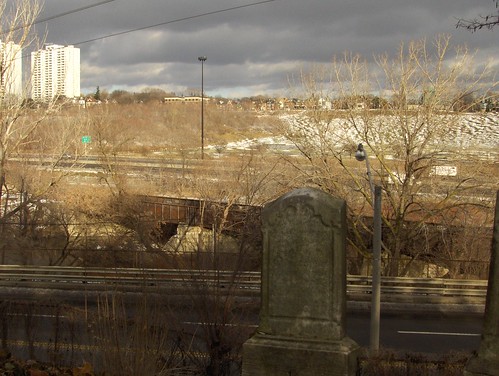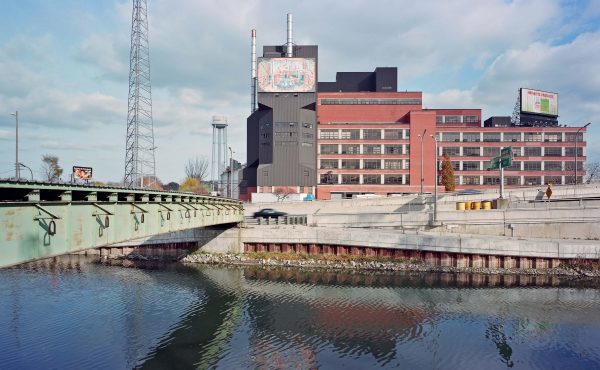
David pointed to where a pedestrian bridge spanned the Bayview Extension. “That was the edge of town for sixty years — the necropolis is right behind those trees. And you go down here†— his arm tracked slowly south — “and that was the middle of town. I guess it still is. Generally, you moved into the necropolis by the time you were fifty-five. That was old age. That makes me a lucky man, doesn’t it?â€
– from Consolation, by Michael Redhill, page 145
Editor’s Alert: Some early plot details revealed in this post.
Consolation is a book about hope and optimism and forward-looking bravery, and so on, but first it is a book about death. Death comes in with the title and stays throughout the book; it looks over David Hollis’s shoulder as he confronts ALS, it haunts his surviving family, and it courts every character in the desolate, squalid muck of early Toronto. So it’s fitting that Consolation’s geography is full of ghosts: two graveyards — Potter’s Field and the Toronto Necropolis — make repeat appearances throughout the book.
In the passage above, David Hollis takes a fateful drive with his prospective son-in-law, John, and acts as a wistful tour guide as they head south through the city. David is dying; he is on his way to die, and his speech to John is an elegy to the city he lived for. He describes a city long gone — the Toronto of the mid-19th century — and its ghosts hover over the landscape as the two men drive through it. He points to the necropolis, a picturesque graveyard on the edge of Cabbagetown , which looms above the river, where the city used to stop.
The necropolis was the city’s second non-sectarian cemetery; the first was the York General Burying Ground, sometimes called the “Strangers’ Burying Ground,†but known most familiarly as Potter’s Field. A six-hectare plot of land, Potter’s Field opened in 1826 in anticipation of a population boom and of an assortment of scourges such as smallpox, scarlet fever, and tuberculosis. At the time of its purchase, Potter’s Field was at the edge of town, at least a mile north of the nearest building. We know the area today as the corner of Yonge and Bloor.

By 1855, Toronto’s population had exploded and the city had already sprawled north far enough to surround the cemetery. Potter’s Field was sold, and the town of Yorkville, a going concern, was able to fill in the spaces. The bodies were exhumed and relocated to Mount Pleasant Cemetery and the Toronto Necropolis.
The trustees of the York General Burying Ground must have expected this exodus, because they bought the necropolis in 1850. Nine hundred of the Potter’s Field dead were re-buried in the necropolis, and they’re still there now. Today, it is a lovely, verdant graveyard, complete with a Victorian gothic chapel and crematorium. Located in Cabbagetown on the edge of the Don Valley, it’s also within mooing distance of the Riverdale Farm. It contains some of the city’s most notable corpses: William Lyon McKenzie, for example, first mayor of Toronto and leader of a failed rebellion, is buried here. So are Ned Hanlan, famous for his skills as an oarsman (and for the naked beach named after him); George Brown, famous for his newspaper, The Globe, (and for the school named after him); Matt Cohen, the author who wrote in and about Toronto; and Ainsworth Dyer, a Canadian soldier killed in Afghanistan. According to its website, there are still some plots available at the necropolis, but space is running out — so act fast.

Space ran out at Potter’s Field, which had once stood beyond the edge of town. And it’s running low at the necropolis, which also used to stand at the city’s edge. It makes sense that, back when we had lots of room to work with, people wanted to keep death at a distance: close enough that they still felt connected to their dearly departed, but far enough that they had a sense of having to travel to their own graves — that they still had a long way to go. Now, our cities sprawl like spilled milk; we can’t keep up with them, and so our graveyards are all around us. Yonge and Bloor, where our city’s souls first rested, is now a squall of commerce and traffic, and the necropolis now looks over a screaming ten-lane parkway. Our graveyards are in our backyards. We live with the dead; we shortcut past them on the way home from work.

Death is in our midst, but we are even more remote from it than were our tubercular forebears: for them, it was a daily concern, and they respected its ubiquity. Now, we’re just as mortal as we ever were, but it’s hard to imagine the relationship that people in 1850s Toronto — people like Consolation’s Jem Hallam and Sam Ennis — had with their own mortality.
Photos by Shawn Micallef


